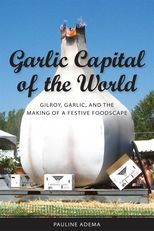Garlic Capital of the World: Gilroy, Garlic, and the Making of a Festive Foodscape
Garlic Capital of the World: Gilroy, Garlic, and the Making of a Festive Foodscape
Cite
Abstract
According to this book, you smell Gilroy, California, before you see it. The book examines the role of food and festivals in creating a place brand or marketable identity. The author scrutinizes how Gilroy successfully transformed a negative association with the pungent garlic bulb into a highly successful tourism and marketing campaign, and explores how local initiatives led to the iconization of the humble product there. The city, a well-established agricultural center and bedroom community south of San Francisco, rapidly built a place-brand identity based on its now-famous moniker, “Garlic Capital of the World.” To understand Gilroy’s success in transforming a local crop into a tourist draw, the book contrasts the development of this now-thriving festival with events surrounding the launch and demise of the PigFest in Coppell, Texas. Indeed, the Garlic Festival is so successful that the event is all that many people know about Gilroy. The author explores the creation and subsequent selling of foodscapes or food-themed place identities. This seemingly ubiquitous practice is readily visible across the country at festivals celebrating edibles such as tomatoes, peaches, spinach, and even cauliflower. Food, the author contends, is an attractive focus for image makers charged with community building and place differentiation. Not only is it good to eat; food can be a palatable and marketable symbol for a town or region.
-
Front Matter
-
One
Making a Foodscape: Gilroy and the Iconization of Garlic
-
Two
The Festivalization of Garlic: Creating and Celebrating Community in Gilroy
-
Three
From Foreign to Fad: Garlic’s Twentieth-Century Transition
-
Four
Garlic Galore: Festival Inversion, Subversion, and the Enactment of Labor Relations
-
Five
Place Branding and Selling Place: Creating and Marketing Identity Capital
-
Six
“This little piggy went to PigFest …”: The Paradox of PigFest
-
Seven
Festive Foodscapes: Food Symbolization and Place Making
-
End Matter
Sign in
Personal account
- Sign in with email/username & password
- Get email alerts
- Save searches
- Purchase content
- Activate your purchase/trial code
Institutional access
-
Sign in through your institution
- Sign in with a library card Sign in with username/password Recommend to your librarian
Institutional account management
Sign in as administratorPurchase
Our books are available by subscription or purchase to libraries and institutions.
Purchasing information


Get help with access
Institutional access
Access to content on Oxford Academic is often provided through institutional subscriptions and purchases. If you are a member of an institution with an active account, you may be able to access content in one of the following ways:
IP based access
Typically, access is provided across an institutional network to a range of IP addresses. This authentication occurs automatically, and it is not possible to sign out of an IP authenticated account.
Sign in through your institution
Choose this option to get remote access when outside your institution. Shibboleth/Open Athens technology is used to provide single sign-on between your institution’s website and Oxford Academic.
If your institution is not listed or you cannot sign in to your institution’s website, please contact your librarian or administrator.
Sign in with a library card
Enter your library card number to sign in. If you cannot sign in, please contact your librarian.
Society Members
Society member access to a journal is achieved in one of the following ways:
Sign in through society site
Many societies offer single sign-on between the society website and Oxford Academic. If you see ‘Sign in through society site’ in the sign in pane within a journal:
If you do not have a society account or have forgotten your username or password, please contact your society.
Sign in using a personal account
Some societies use Oxford Academic personal accounts to provide access to their members. See below.
Personal account
A personal account can be used to get email alerts, save searches, purchase content, and activate subscriptions.
Some societies use Oxford Academic personal accounts to provide access to their members.
Viewing your signed in accounts
Click the account icon in the top right to:
Signed in but can't access content
Oxford Academic is home to a wide variety of products. The institutional subscription may not cover the content that you are trying to access. If you believe you should have access to that content, please contact your librarian.
Institutional account management
For librarians and administrators, your personal account also provides access to institutional account management. Here you will find options to view and activate subscriptions, manage institutional settings and access options, access usage statistics, and more.